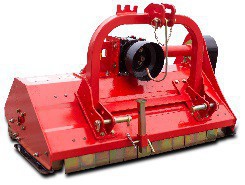Preparing your flail mower for winter storage is key to ensuring its longevity and efficiency in future seasons. Here are tips on how to effectively care for your machine so it can serve you flawlessly again in the spring.
Preparing the flail mower for winter: step by step
The flail mower is an indispensable tool for anyone tending larger green spaces, whether amateur or professional. However, in order for it to serve us effectively for many seasons, proper maintenance is extremely important, especially before the winter period, when the machine will be out of use for several months. Preparing your flail mower for winter is a key process that not only protects the machine from harmful weather conditions, but also minimises the risk of damage.
Below you will find a comprehensive guide on how to properly prepare your flail mower for winter so that it can perform flawlessly next season.
1. thoroughly cleaning your flail mower before winter
We start by thoroughly cleaning the entire mower. Before winter, it is a good idea to thoroughly clean all components, including the drum, flails and drive shaft. Grass residue, mud, plant debris and other deposits not only make the equipment look unsightly, but can also contribute to corrosion of metal parts.
- Dirt removal: Use pressurised water or special cleaners to do this. Use a brush to remove loose dirt from all surfaces of the machine, including the blades and housing. You can also use a pressure washer for deeper cleaning, but remember not to direct the water spray directly onto bearings and electrical components. Make sure you remove any plant debris that can cause corrosion and rot.
- Check for rust: Check for rust on metal parts. If so, remove it with sandpaper or a wire brush and then coat the area with an anti-corrosive agent.
2. Checking and replacing drum beaters
During the season, flails can become worn or damaged. It is a good idea to check their condition carefully before winter. Pay attention to the sharpness of the knives. Sharp knives have a big impact on the efficiency of the mower. If they are dull, they should be sharpened or replaced.
Replace flails that are excessively worn, cracked or deformed. In this way, you minimise the risk of your mower breaking down at the start of a new season. Regular replacement of flails is also a key part of flail mower maintenance.
3. Drive and power take-off (PTO) maintenance
Ensure the maintenance of the power take-off (PTO), which plays a key role in the operation of the mower. Check that the drive shaft is in good condition, that the guards are intact and that all components are well lubricated. Make sure the PTO shaft is not damaged and is working properly. If it is damaged, it is necessary to replace the shaft. It is also a good idea to disconnect the shaft from the tractor and store it in a dry, protected place.
4. Checking and replacing components
Winter is a good time to thoroughly check the condition of all mower parts and replace those that are worn or damaged. Replacing worn or damaged parts on flail mowers is essential to avoid unexpected downtime and expensive repairs during the season.
- Filters and oil: Change the engine oil and the oil and air filters. This will provide better engine protection and help maintain optimum performance.
- Drive belts: Check the condition of the drive belts. Replace them if you notice cracks or other damage that could lead to failure during operation.
5. Lubrication of moving parts
Flail mowers have many moving parts that are subject to wear and tear. In winter, when the machine is not in use, it is a good idea to ensure that all moving parts such as bearings, joints or shafts are properly lubricated. Lubrication minimises friction and protects against corrosion, allowing the machine to run smoother the following season.
6. Corrosion protection
Flail mowers in winter are exposed to moisture and low temperatures, which can lead to corrosion. After thorough cleaning and lubrication, it is a good idea to protect the metal parts with special anti-corrosion preparations. You can use oil-based protective preparations that form a protective layer on the surface of the machine and prevent rusting. This will ensure that your flail mower will be ready for use the following season.
7. Maintenance of the fuel system
Old fuel is one of the main causes of problems with starting the mower after winter. To prevent this, the fuel system must be properly maintained.
- Emptying the tank: Empty the fuel tank and let the engine run until it has used up the rest of the fuel in the system.
- Cleaning the carburettor: Clean the carburettor to remove any accumulated debris that could clog the throttles or nozzles.
8. Storing a flail mower in winter
Choosing a suitable place to store your flail mower for the winter is just as important as the process of preparing for the winter season itself.
- Dry and sheltered location: Place the mower in a dry, sheltered location to protect it from moisture and extreme temperatures. A garage or other enclosed storage area would be ideal.
- Cover: If you do not have an enclosed space, cover the mower with a tarpaulin or special cover to protect it from rain and snow.
Winterising the flail mower
Properly preparing your flail mower for winter will ensure long and trouble-free use in subsequent seasons. This will avoid unforeseen breakdowns and costly repairs, and your mower will be ready to go as soon as spring arrives. Maintenance and proper storage are key to maintaining the performance and longevity of this valuable garden equipment.
Need help?
You can find a wide selection of lawnmowers at bijakowe.pl. This is a shop that specialises in this type of machine. If you need help, please contact us. Our specialists will be happy to help you!












